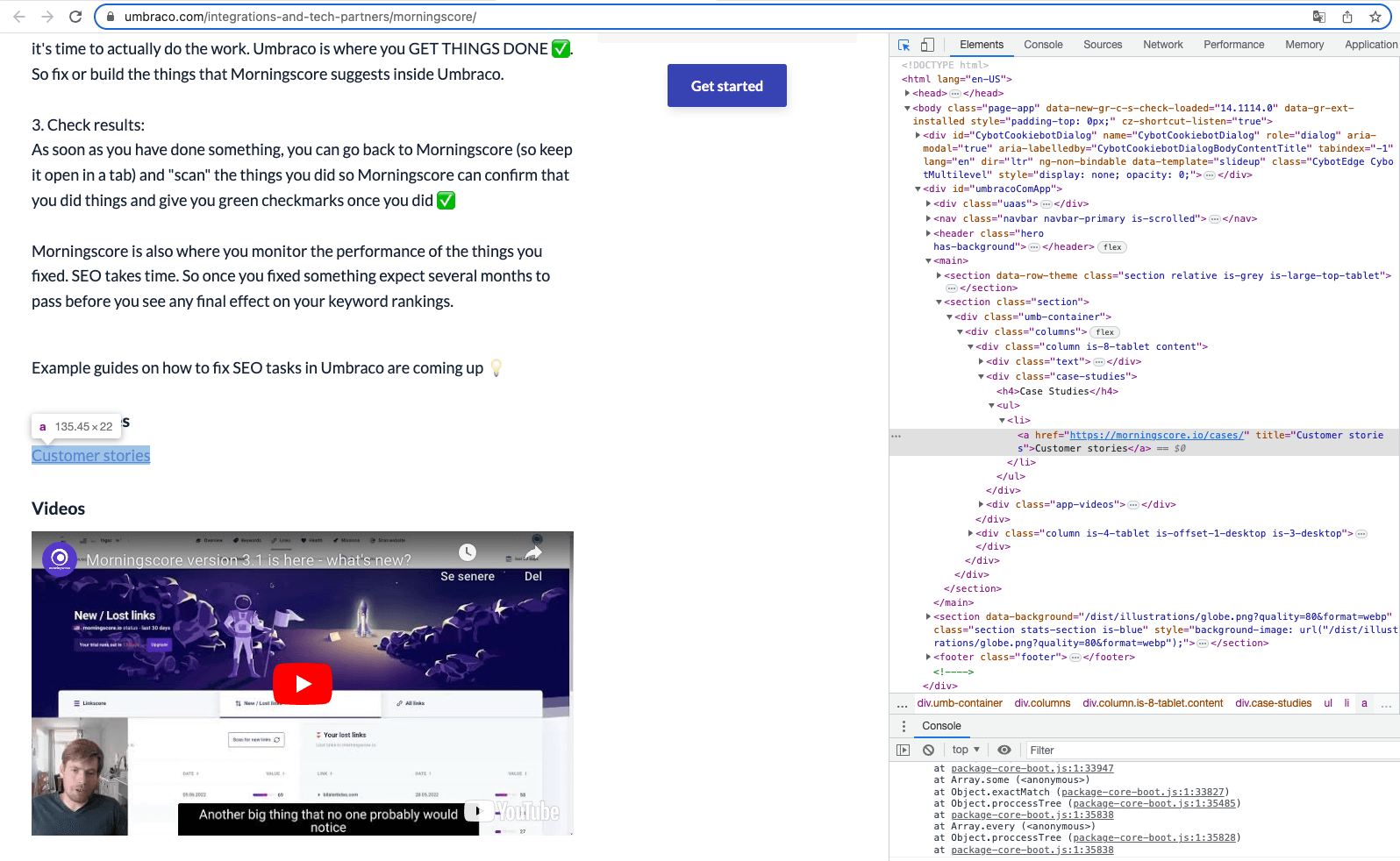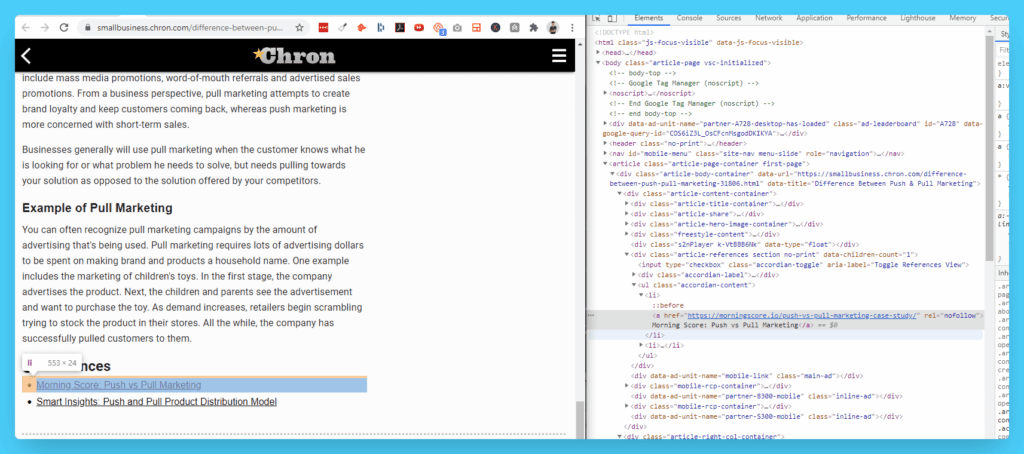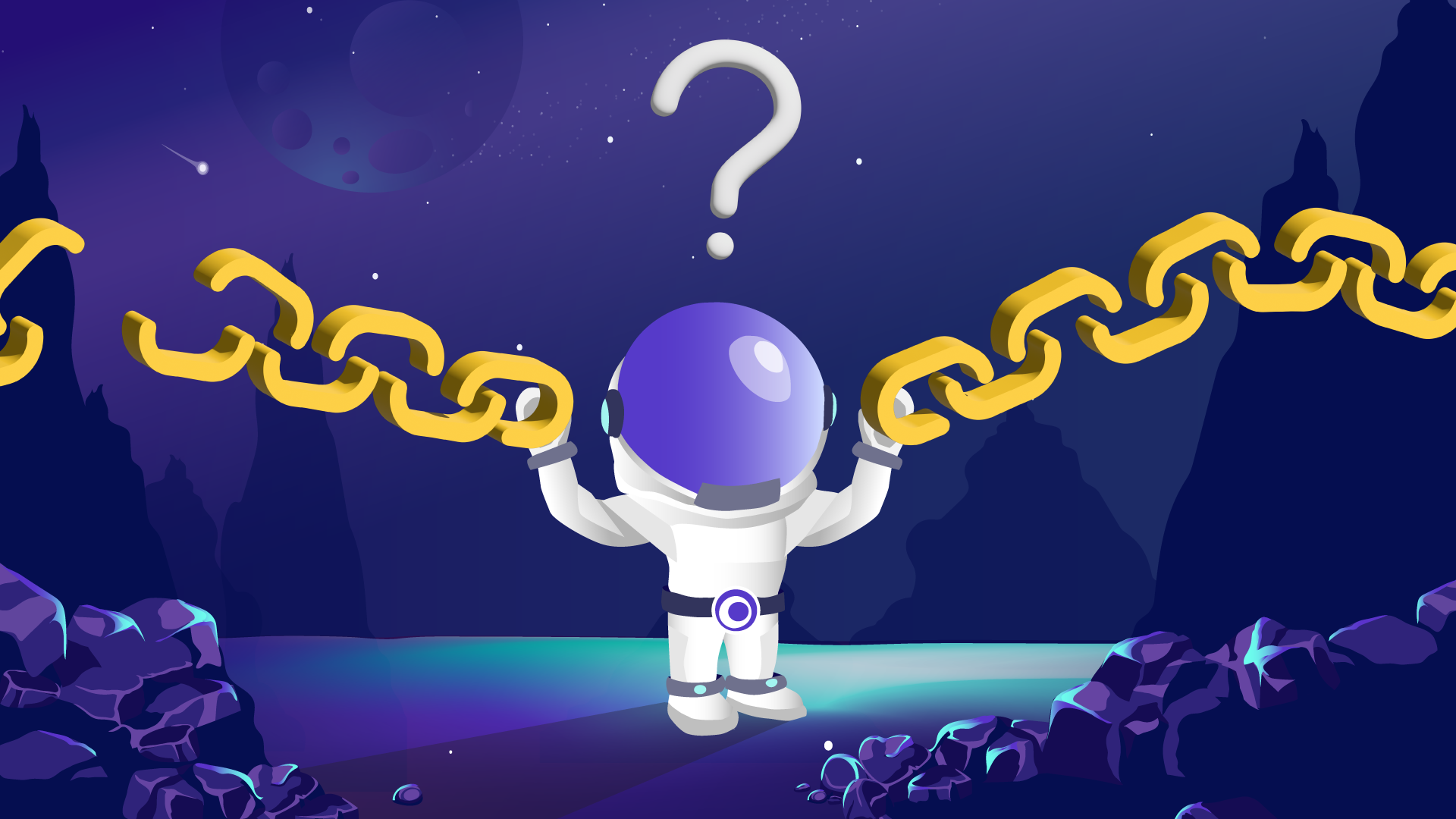It’s widely recognized that backlinks play a crucial role in determining a website’s authority and visibility. Among the various types of backlinks, two important distinctions are often mentioned: dofollow and nofollow backlinks. They serve as powerful ranking factors that can either elevate your website to the top or cause it to plummet to the bottom.
In this article, we will delve into the world of backlinks, exploring what dofollow and nofollow backlinks are, and understanding the key differences between them.
As a general rule, dofollow and nofollow backlinks are two ways to hint at whether search engines should pass website authority from the origin website to the destination website. As a rule of thumb, dofollow backlinks pass on website authority, while nofollow links do not.
Think of backlinks as endorsements or “votes of trust” exchanged between websites. Both dofollow and nofollow links play a crucial role in how the internet operates and how these endorsements are distributed. Oftentimes, you may want to link to a website because you have discovered something interesting or valuable there. When using dofollow links, you are essentially telling Google that this source is reputable and worthy of trust. Generally, a dofollow backlink signifies that the originating website recommends the destination website, although multiple factors contribute to determining the quality and impact of a backlink.
However, you want to showcase or reference a website without specifically recommending it in some instances. If all backlinks equally acted as votes of trust, the internet would be a much different place. For example, sometimes you need to link a page but don’t necessarily “recommend it” to search engines – which can often be the case with journalists.
Other times, you want to tell Google that certain content is user-generated and should not be treated as a recommendation because it’s self-servicing – this is for example in comment sections on blogs, forums, etc. In both cases, you need a way to hint that to search engines. This is where nofollow comes into play. Nofollow backlinks hint to search engines that the linked resource shouldn’t necessarily receive any authority – or link juice – from the link.
Search engines need to derive meaning from content on the web. While we’ve seen significant advancement in AI in recent years, this wasn’t the case for a long time. Search engines now have an easier time understanding the content of your page in a more human-like manner. However, they still need hints and signals to understand web content.
That’s also part of why there are so many types of technologies, data, and markup you can use to provide that information. They all help search engines understand the context, relevance, and purpose of what is happening on the web.
Dofollow and nofollow backlinks are similar factors that apply to backlinks specifically. Dofollow backlinks are all the default backlinks on the web, and by default, they distribute authority between websites. Nofollow backlinks differ in that they suggest that the origin website doesn’t recommend the destination website – and thus, search engines should not pass on website authority.
The reason why dofollow and nofollow work this way is that search engines need a more objective way to judge where websites should rank. If all you had to do to rank at the top were related to your website (i.e., on-page SEO), this system would be very subjective. That’s because everyone tries to show themselves in their best light.
However, a system that involves outside parties judging your content (i.e., off-page SEO) can be more objective. If other websites have to give you “votes of trust,” it means you can’t easily cheat your way around rankings. That’s the very reason you cannot get a university degree all by yourself. Experienced teachers in your industry have to accredit your knowledge and expertise.
What are dofollow backlinks, and how do they work?

Technically, “dofollow” backlinks aren’t a real thing. That’s because they are simply the default links on the web and don’t require any additional attribute to “become dofollow.” So to create a dofollow link, you don’t need to change the link or add any additional attributes. Dofollow links simply do not have the nofollow attribute.
Because dofollow links are standard and you don’t have to make any specific changes to use them, it is easy for you to create them. Similarly, it’s easy for other webmasters to do the same when linking to your content.
Dofollow backlinks are broadly defined as signals for search engines to direct a share of the origin website’s authority to the destination website. Essentially, dofollow backlinks are “votes of trust.” By default, all links are dofollow and do not require a rel=” dofollow” attribute to be used.
Dofollow backlinks (also known as “follow”) are the “original” type of links that pass value (also known as link juice) between web pages. Google uses these links to increase the PageRank value of the linked page. You can think of dofollow links as the best type of inbound link you can get because they provide the most value. However, naturally, many more factors determine whether a link is good or bad besides “dofollow.”
To understand why dofollow links work this way, imagine that you find a great source while writing an article for your customers. It could be supplementary material, a review of your product, a case study, or anything else. In this case, you want to add a dofollow link because it tells search engines that you recommend the website you’re pointing to.
See, dofollow backlinks are clear signals to search engines that you want to give your vote of trust to the other website. In other words, you “recommend” that resource. This is important for search engines because it fits their goal of satisfying the end user. If users are happy and get their search needs met, they will return and use the search engine again. Otherwise, no one will be using the platform.
A dofollow link, i.e., a vote of trust, is a way for search engines to determine whether the page you’re linking to deserves value (and, therefore, deserves to rank higher). If many authoritative websites create contextual links to a specific resource, Google will judge that website as relevant and valuable. It will then prioritize it in search rankings.
An example of a dofollow backlink
To showcase what a dofollow link looks like in the code, let’s look at a real-life example. Here’s an example of a high-quality dofollow link we got from the website umbraco.com which is detected in our own backlink checker tool. The dofollow link placed on their website is pointing toward one of our pages and looks like this:
<a href=”https://morningscore.io/cases/”>Customer stories</a>
Here’s a screenshot of what it looks like on the page and in the code.

What are nofollow backlinks, and how do they work?
Things are slightly different with the nofollow attribute (sometimes incorrectly referred to as “nofollow tag”). Nofollow links require you to make a specific change in the HTML code where the link is placed. Because of that, it can be more intimidating to nofollow a link for non-technical website owners. However, in reality, things are very simple. Let’s look at what nofollow links are and how they work.
Nofollow backlinks are broadly defined as links that do not pass authority from the origin website to the destination website. As a general rule, nofollow backlinks do not improve your SEO. To create a nofollow link, add the rel= “nofollow” attribute to the code when linking out.
In reality, all a nofollow link needs is a rel=” nofollow” attribute to the “<a>” tag in a link. Doing this tells search engines there is a link, but the origin website doesn’t necessarily recommend the destination website.
Nofollow links were introduced in 2005 by Google to combat content spam. In particular, nofollow links helped reduce comment spamming on popular blogs, which was a growing practice at the time.
In other words, the nofollow attribute was added to allow links to a website but prevent the origin page from passing PageRank value to it. Besides combatting web spam, nofollow links also have a utility for many other content creators.
To understand that better, imagine you are a journalist writing a news article for a big media outlet. Often, it happens so that you have to link to smaller pages that you don’t necessarily trust or recommend. Say you’re covering something negative that a specific company did. In these cases, using the nofollow attribute is an excellent option because it tells Google that you point to a website but do NOT necessarily recommend or trust it.
In simple terms, the nofollow attribute simply tells Google that the destination website has not earned a “vote of trust,” although it has a backlink from the origin website. As the name itself suggests, Google did not even crawl (follow) nofollow links for a long period.
However, although we could not find credible research yet, we believe this changed at some point due to Google trying to detect and combat web spam. Our reasoning for this belief is that Google needs to keep tabs on how website owners act on the internet to find behavioral patterns and determine better when someone wants to trick the algorithm.
Because of these reasons, for a long time, nofollow links were thought of as low-value backlinks as they didn’t help you rank higher in Google. In the past, Google used to treat nofollow links as a “directive.” That is, the nofollow attribute was directing Google not to pass website authority.
However, with the evolution of the internet, this changed in 2019 when Google decided to potentially let some nofollow links pass value based on whether they were contextually relevant and well placed. They now treat the nofollow attribute as a “suggestion” or a “hint”‘ – and nowadays, some links potentially contribute to your PageRank.
An example of a nofollow backlink
To make things easier to understand, let’s quickly look at an example of a real nofollow backlink. The backlink below is part of our backlink profile, where the website chron.com has an outbound link to our article as a source in their post.
<a href=”https://morningscore.io/push-vs-pull-marketing-case-study/” rel=”nofollow”>Morning Score: Push vs Pull Marketing</a>
As you can see, they have used the rel=” nofollow” attribute, telling search engines not to count this link in terms of rankings. When comparing the link to the dofollow link example from above, you can quickly see where the difference lies. The additional attribute dictates that they are nofollow. And here’s a screenshot of what the nofollow link looks like on the page and in the code.

This example is quite interesting because it stands out in a particular way. As we established, the nofollow attribute is generally used to combat spam or denote promotional content. For some links, there is a specific purpose to add a nofollow tag – for example, affiliate links are considered promotional, and a backlink shouldn’t be treated as a “vote of trust.”
However, in many other websites, this is done by default in the way the website is set up. Although the link is placed contextually and is very relevant to the topic, some webmasters chose to nofollow links.
This happens because some websites often link to many other websites (like Chron in the example above). In this case, website owners are careful about destroying their reputation with Google by linking to websites that are not trusted.
Any of the thousands of websites they link to can get acquired by someone with bad intentions and the content can be changed to spam. This could hurt Chron as well since, in Google’s eyes, they would be recommending irrelevant and spammy websites.
On the other hand, some webmasters are also afraid of “leaking” their PageRank to other websites. In theory, a leaking PageRank means you have too many dofollow outbound backlinks to other websites. In such a case, it is assumed that your website loses some of its authority and cannot rank well in Google because you “don’t get to keep enough authority for yourself.”
Key Differences Between Dofollow and Nofollow Backlinks
Link Juice and SEO Impact
The primary difference between dofollow and nofollow backlinks lies in the way they impact search engine optimization. Dofollow backlinks pass link juice, helping the linked site gain authority and potentially improve its search engine rankings. Nofollow backlinks, on the other hand, do not pass link juice and have no direct impact on SEO.
However, it is essential to note that nofollow links can still drive traffic to a website and contribute to its overall online visibility.
Crawlability and Indexing
Search engine crawlers follow dofollow backlinks to discover and index new content. These backlinks facilitate the flow of link equity throughout the web, leading to increased visibility and better chances of ranking. Nofollow backlinks, however, are not crawled or indexed by search engines, which means they do not directly contribute to a site’s visibility in search results.
Nevertheless, nofollow links can still attract human visitors and generate referral traffic.
User-Generated Content and Social Media Platforms
Nofollow backlinks are commonly used in user-generated content (UGC) platforms and social media networks. Platforms like blogs, forums, and comment sections often implement nofollow attributes by default to prevent spam and discourage manipulative SEO tactics. Social media platforms also utilize nofollow attributes on user-generated links to maintain a healthy user experience and prevent abuse.
Balancing Dofollow and Nofollow Backlinks
While dofollow backlinks hold more SEO value, it is crucial to strike a balance between both types of links in a website’s backlink profile. A natural backlink profile should include a mix of dofollow and nofollow backlinks to appear organic and avoid potential penalties from search engines. Additionally, a diverse link profile demonstrates that a website is trusted and respected by both users and search engines.
Conclusion
In conclusion, dofollow and nofollow backlinks differ significantly in terms of their impact on search engine optimization. Dofollow backlinks pass link juice, contribute to higher search engine rankings, and facilitate the discovery of new content. Nofollow backlinks, while not directly influencing SEO, still play a role in driving traffic and increasing a website’s visibility. Maintaining a healthy balance of both types of backlinks is essential for a comprehensive and effective SEO strategy.
By understanding the distinctions between dofollow and nofollow backlinks, webmasters and SEO practitioners can make informed decisions about their link-building efforts, ultimately contributing to the growth and success of their websites in the digital landscape.












